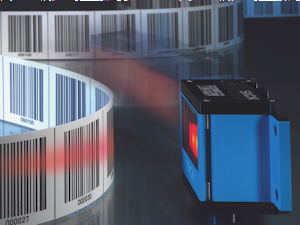Camera reads barcodes to detect linear position
Sick has developed a linear position sensing system that uses a digital camera sensor to read barcodes and thus to provide accurate, high-speed, non-contact positioning on straight or curved tracks. The OLM100 system can determine linear positions to a resolution of 0.1mm over distances of up to 10km in applications such as overhead conveyors, rotary tables, slewing rings, hoisting systems and robots.

The camera is mounted on the moving part, a distance of 80–120mm from a tape that contains barcodes at 3cm intervals. The 1,024-pixel CMOS array sensor reads up to three barcodes at a time to build an absolute positional value, even if some barcodes are missing or damaged.
The Sick system differs from similar systems that user laser scanners to read barcodes. According to Sick`s distance sensor product specialist in the UK, Darren Pratt, an advantage of the camera-based sensor is that it has no moving parts, unlike laser-based barcode scanners which incorporate rotating mirrors.
“As the read head is generally situated on an automated machine, such as a crane or vehicle, it is often subject to shock and vibration,” he explains. “By negating the need for moving parts, which can suffer wear and damage, the life expectancy of the sensor can be greatly increased.
The barcodes are illuminated by four red LEDs with a life expectancy almost twice as long as laser diodes. According to Pratt, “this means that you can expect to get 100,000 hours of use, as opposed to the average 50,000 hours from a laser diode.”
The tough polyester barcode tapes are impervious to most oils, greases, fuels, solvents and weak acids. To simplify installation, it is only necessary to install the tape where positional information is needed. If it gets damaged, replacement barcode tapes can be created by downloading the code from Sick`s Web site and printing it out.
The system is said to be easy to mount and align, and does not need continuous calibration, thus saving both time and money. It is also easy to program, via Ethernet, using dedicated software. Available outputs include SSI, RS-422, RS-485 and CANopen. DeviceNet and Profibus DP versions are planned.
The sensing system can operate at speeds up to 4m/s. It will work in temperatures from –30°C to +60°C, allowing it to be used in cold stores. In the UK, the sensing head costs about £750 and the barcode tape about £8/m.





